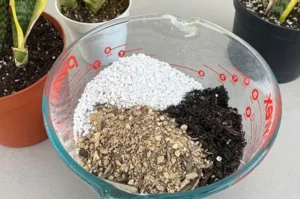Snake plants are known for their bold, upright leaves and low-maintenance nature. They’re a favorite among plant lovers and beginners alike. But sometimes, these firm vertical leaves start to droop, bend, or fall over, which can be frustrating.
If your snake plant isn’t standing tall anymore, don’t worry. This guide will help you understand why it happens and exactly what you can do to fix it. Let’s dive into how to keep your snake plant standing proud and healthy.
Why Do Snake Plants Fall Over?
Before you can fix the problem, you need to figure out what’s causing it. Here are the most common reasons snake plant leaves droop:
1. Overwatering
This is the number one cause. Snake plants store water in their leaves and roots. If you water too often, the roots may rot, making the leaves soft and unable to support themselves.
2. Underwatering
Yes, the opposite can also be a problem. When a snake plant doesn’t get enough water for a long time, its leaves start to wrinkle, become dry, and eventually droop.
3. Poor Lighting
Snake plants tolerate low light, but if they’re stuck in a very dark corner, they may stretch toward the nearest light source, causing the plant to lean.
4. Pot is Too Big or Too Small
A pot that’s too large can retain too much moisture, while a very small pot may restrict the root system. Both affect the plant’s balance.
5. Root Bound or Weak Roots
If the plant has outgrown its pot, roots get tangled and can’t absorb water or nutrients properly. This weakens the plant and makes it less stable.
6. Heavy Leaves
Some varieties naturally grow thick, tall leaves. If they get too tall without enough support from the base, they start to lean or fall over.
How to Keep Snake Plants Upright
Let’s look at practical, proven ways to help your snake plant stay upright and healthy:
1. Water Wisely
Stick to a simple rule: only water when the soil is dry about 2–3 inches deep. You can test this with your finger or a wooden stick. Snake plants don’t like wet feet, and overwatering causes root rot quickly.
Tip: Use pots with drainage holes and never let your plant sit in water.
2. Choose the Right Pot and Soil
Pick a pot that’s heavy and stable, especially for taller plants. Terracotta pots are a great choice because they’re heavy and absorb extra moisture.
Use a well-draining soil mix. You can buy a succulent or cactus mix, or make your own using:
- 2 parts potting soil
- 1 part perlite
- 1 part coarse sand or pumice
Good soil helps roots stay healthy and firm, which keeps leaves upright.
3. Give It Proper Light
Place your snake plant in bright, indirect light. If the plant is leaning toward a window, it’s a sign it needs more light. Rotate the pot every couple of weeks so all sides grow evenly.
If you’re in a low-light home, you can use a small grow light to supplement.
4. Support Heavy Leaves
Sometimes, healthy leaves just grow too tall and heavy. You can support them with bamboo sticks or small plant stakes. Insert the stick close to the base and gently tie the leaf to it with soft twine or garden tape.
This isn’t cheating, it’s simply helping your plant stay balanced.
5. Repot When Needed
If your snake plant’s roots are poking out of the pot or the soil dries out too quickly, it’s time to repot. Choose a pot that’s 1–2 inches wider than the current one. This gives the roots room to grow and strengthens the plant’s base.
Repot every 2–3 years, or sooner if needed.
6. Prune Damaged Leaves
If some leaves are drooping beyond repair or feel mushy, they should be removed. Use clean scissors to cut them at the base. Removing damaged parts allows the plant to focus its energy on new, healthy growth.
Bonus: You can use the cuttings to propagate new snake plants!
7. Watch for Pests and Disease
Sometimes, pests like mealybugs or spider mites can attack the plant and weaken its structure. Check under the leaves regularly. If you see pests, wipe them off with a damp cloth and spray with neem oil or insecticidal soap.
Also, if you notice a foul smell or black roots when repotting, you may be dealing with root rot. Remove the rotten parts and repot in fresh, dry soil.
Frequently Asked Questions (FAQs):
Can a drooping leaf become upright again?
If the leaf is healthy and just leaning, it can sometimes perk up with better care. But if it’s too damaged, it’s best to trim it and let the plant grow new, stronger leaves.
How do I know if my snake plant is overwatered?
Soft, mushy leaves and a rotten smell from the soil are classic signs. The base of the plant may look brown or black.
Should I use fertilizer?
You don’t need to fertilize often. A balanced houseplant fertilizer once every 2–3 months during spring and summer is enough.
Final Thoughts
Snake plants are hardy, but they do need the right care to grow upright. Most issues with drooping or leaning come from watering mistakes, poor light, or tight roots. Luckily, these are all easy to fix.
Keep an eye on your plant, listen to its signals, and give it a stable environment. With a little attention, your snake plant will reward you with tall, strong, upright growth and keep looking amazing for years.






